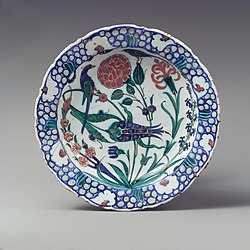Category:Dish Depicting Two Birds among Flowering Plants - Iznik (Turkey) - 16th century - MET - Inventory number 59.69.1
| Dish Depicting Two Birds among Flowering Plants
|
||||||||||||||||||||||||
|---|---|---|---|---|---|---|---|---|---|---|---|---|---|---|---|---|---|---|---|---|---|---|---|---|
| Title |
Dish Depicting Two Birds among Flowering Plants - Iznik (Turkey) - 16th century - MET - Inventory number 59.69.1 |
|||||||||||||||||||||||
| Object type |
dish |
|||||||||||||||||||||||
| Description |
|
|||||||||||||||||||||||
| Date | ca. 1575–90 | |||||||||||||||||||||||
| Medium | Stonepaste; polychrome painted under transparent glaze | |||||||||||||||||||||||
| Dimensions | H. 2 3/8 in. Diam. of rim: 11 3/16 in. (28.4 cm) | |||||||||||||||||||||||
| Collection |
|
|||||||||||||||||||||||
| Current location |
Islamic Art |
|||||||||||||||||||||||
| Accession number |
59.69.1 |
|||||||||||||||||||||||
| Place of creation |
Turkey |
|||||||||||||||||||||||
| Object history | Brimo de Laroussilhe, Paris, until 1959; sold to MMA | |||||||||||||||||||||||
| Exhibition history |
Washington. National Gallery of Art, Washington D.C. "The Age of Sultan Süleyman the Magnificent," January 25, 1987–May 17, 1987, no. 199. Chicago. Art Institute of Chicago. "The Age of Sultan Süleyman the Magnificent," June 14, 1987–September 7, 1987, no. 199. The Metropolitan Museum of Art. "The Age of Sultan Süleyman the Magnificent," October 4, 1987–January 17, 1988, no. 199. |
|||||||||||||||||||||||
| Credit line | Gift of James J. Rorimer in appreciation of Maurice Dimand's curatorship, 1933–1959, 1959 | |||||||||||||||||||||||
| Notes |
Otttoman period Hidden within the tangle of carnation, tulip, and hyacinth stems on this colorful plate perch two small birds. Such flowers, sometimes in combination with birds, were pervasive decorative elements on Iznik pottery of the sixteenth and seventeenth centuries. By the 1580s the Iznik potters began to produce original pottery with a wide variety of highly innovative and sometimes quite mannered or quirky designs that often had little to do stylistically with the professional design atelier in Istanbul. This polychrome Iznik dish with a scene of birds among flowers, contained within the familiar late rim design of tight spirals, is such a work, but in all likelihood there is an implied narrative behind the simple floral composition that is not readily apparent to the twenty-first-century viewer.[1] The central tondo contains five main "actors": a bird, probably a nightingale, facing right; a rose immediately to the right of the bird; a honeysuckle to the right of the rose; a spray of hyacinths below the honeysuckle; and a tulip in the center of the plate—all growing from the same clump of leaves. A smaller bird and a spray of six-petaled flowers, both bit players, round out the cast. The lead characters are most likely the rose and the nightingale, which together were popular allegorical subjects of love poetry for Ottoman poets of the fifteenth through the eighteenth century. Other flowers, such as tulips, carnations, honeysuckles, and hyacinths, also frequently played roles in such poetry, and it seems highly plausible that the Metropolitan’s dish represents a visualization of this popular Ottoman literary trope. In his "The Rose and the Nightingale" of about 1563, the poet Fazli (d. 1563) evoked the realm of the King of Springtime: "’Midst his blest dominions none uttered wail, / Save it were ‘mongst the flowers the sad nightingale."[2] The seventeenth-century poet Neshati (d. 1674) wrote: "We are desire hidden in the love-crazed call of the nightingale / We are blood hidden in the crimson heart of the unbloomed rose."[3] Because of their great cost and beautiful decoration, Iznik dishes like this one were seldom used for serving food and were instead displayed in the built-in cupboards found in many Ottoman domestic living rooms (such as the Damascus Room in the Metropolitan; no. 1970.170), where their poetic meanings would doubtless have served as a subject of conversation. Walter C. Denny in [Ekhtiar, Soucek, Canby, and Haidar 2011 Footnotes: 1. See Denny 2004, pp. 173–97. 2. This rather quaint nineteenth-century English translation was taken from Gibb, E[lias] J[ohn] W[ilkinson]. Ottoman Literature: The Poets and Poetry of Turkey. New York and London, 1901, p. 99. 3. Andrews, Walter G., et al., eds. Ottoman Lyric Poetry: An Anthology. Austin, 1997, p. 131. (copy from http://metmuseum.org/art/collection/search/451490) |
|||||||||||||||||||||||
| References |
Atil, Esin. The Age of Sultan Süleyman the Magnificent. Washington, DC: Harry N. Abrams, Inc., 1987. no. 199, pp. 272-274, ill. pl. 199 (color). Atasoy, Nurhan, and Julian Raby. Iznik : The Pottery of Ottoman Turkey, edited by Yanni Petsopoulos. London: Thames and Hudson, 1989. no. 484, pp. 245-246, ill. (b/w). Denny, Walter B. Iznik: the Artistry of Ottoman Ceramics. London and New York: Thames and Hudson, 2004. pp. 173–97. Ekhtiar, Maryam, Sheila R. Canby, Navina Haidar, and Priscilla P. Soucek, ed. Masterpieces from the Department of Islamic Art in The Metropolitan Museum of Art. 1st ed. ed. New York: The Metropolitan Museum of Art, 2011. no. 214, pp. 287, 305-306, ill. p. 305 (color). |
|||||||||||||||||||||||
ceramics highlighted in The MET collection | |||||
| Upload media | |||||
| Instance of | |||||
|---|---|---|---|---|---|
| Depicts | bird and flower | ||||
| Location | Metropolitan Museum of Art, Manhattan, New York City, New York | ||||
| Country of origin | |||||
| Collection |
| ||||
| Inventory number |
| ||||
| Inception |
| ||||
| |||||
Media in category "Dish Depicting Two Birds among Flowering Plants - Iznik (Turkey) - 16th century - MET - Inventory number 59.69.1"
The following 4 files are in this category, out of 4 total.
-
Dish Depicting Two Birds among Flowering Plants MET 169151.jpg 1,748 × 1,352; 341 KB
-
Dish Depicting Two Birds among Flowering Plants MET 59.69.1.jpg 1,015 × 1,045; 191 KB
-
Dish Depicting Two Birds among Flowering Plants MET DP131621.jpg 4,000 × 4,000; 2.29 MB
-
Dish Depicting Two Birds among Flowering Plants MET DP132500.jpg 4,000 × 4,000; 2.4 MB






